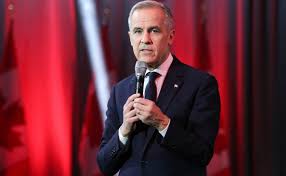Ottawa, March 28, 2025: Canada’s federal election is in full swing, with the Liberals and Conservatives locked in a fierce contest. While the race was expected to be a referendum on the governing party’s record, Donald Trump’s threats of tariffs and annexation have shifted the focus to leadership and national security. The Liberals, once trailing by 25 points, have staged a comeback under Prime Minister Mark Carney—largely by adopting Conservative policies.
Blurring the Lines Between Liberals and Conservatives
With both parties running on nationalist slogans—“Canada Strong” for the Liberals and “Canada First” for the Conservatives—their policy platforms have become strikingly similar. Both promise tax cuts: Carney is offering a 1% reduction for the lowest income bracket, while Poilievre proposes 2.25%. On housing, Carney wants to cut federal sales tax on first-time home purchases up to CA$1 million, while Poilievre raises the cap to $1.3 million and includes non-first-time buyers.
Defense spending is another area of overlap. Carney has pledged to raise military spending to 2% of GDP by 2030 and strengthen Arctic security, mirroring Poilievre’s commitments. Both support energy infrastructure expansion, though Carney plans to keep a Trudeau-era emissions cap that Poilievre would remove.
Even on affordability, Poilievre has surprised many by not vowing to dismantle Liberal programs like public prescription drug coverage, daycare, and dental care. Food insecurity remains a major issue, but neither party has yet proposed bold new measures.
Liberal Reinvention or Repackaged Status Quo?
Carney may be the new face of the Liberals, but his Cabinet is 87% the same as under Justin Trudeau. Critics argue that his leadership is a rebranding rather than a real reset. Some key figures who distanced themselves from Trudeau—like Anita Anand, Sean Fraser, and Nate Erskine-Smith—have now returned, further blurring the lines between old and new.
Adding to the confusion, Carney has reversed some of Trudeau’s flagship policies, including planned increases to the capital gains inclusion rate and the controversial consumer carbon tax—two positions long championed by Poilievre. This has led to accusations that the Liberals are simply mimicking Conservative policies to stay in power.
A “Presidential” Election Focused on Leadership
Analysts describe this election as unusually leader-focused, making it feel more like a U.S. presidential race. Graeme Thompson of Eurasia Group notes that the challenge for Carney is convincing voters that he represents real change after nearly a decade of Liberal rule.
While Carney enjoys high favorability ratings—over half the country views him positively—his political inexperience remains a concern. Having never run a campaign, let alone a national election, he faces scrutiny over whether he can handle the pressures of leadership.
For now, the Liberals are benefiting from an election dominated by Trump’s influence, allowing them to sidestep past policy failures. But if Carney wins, his ability to quickly deliver on his promises will be tested. The honeymoon period, experts warn, will be brief.
New Leader, Old Team: Can Carney Convince Voters the Liberals Have Changed?

